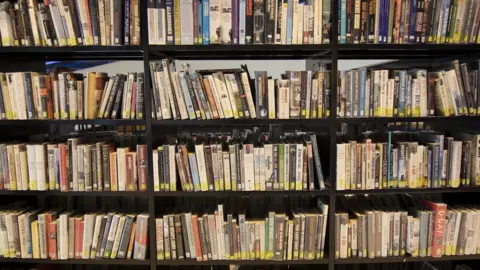Pisa tests: NI pupils better than world average at reading
 Getty Images
Getty ImagesFifteen-year-olds in Northern Ireland have performed much better than the global average in international tests in reading.
However, they were only slightly above the global average in maths and science.
The results were recorded in Pisa tests run by the Organisation for Economic Co-operation and Development (OECD).
The Pisa tests - the Programme for International Student Assessment - take place every three years.
They have become the most influential rankings in international education.
Singapore and four regions in China were ranked as the top education systems in the tests, which were taken in 2018-19 by about 600,000 students in 79 countries and regions.
In Northern Ireland, Pisa 2018 was conducted from October 2018 to January 2019, with a representative sample of 2,360 15-year-old pupils in 75 schools.
There was particular focus on reading skills in this year's OECD analysis.
Within the UK, students from Northern Ireland slightly outperformed their counterparts in Wales but were a little behind those in England in reading, maths and science.
Pupils in Northern Ireland were ranked just above those in Scotland for maths and science, but below them in reading.
The UK as a whole is ranked 14th in the world in reading.
The Republic of Ireland performed better than all UK countries in reading where it is ranked eighth in the world.
 Getty Images
Getty ImagesNorthern Ireland pupils received an average score of 501 in reading, compared with the mean reading score across all OECD countries of 487.
In common with all other participating countries, girls in Northern Ireland outperformed boys in reading but the gender gap was similar to the OECD average.
Pupils from the most advantaged backgrounds in Northern Ireland also had higher reading scores than those from less socio-economically advantaged homes.
Although pupils in Northern Ireland performed above the OECD average in reading tests, they were also less likely to read books and less likely to read for enjoyment than pupils in the OECD area as a whole.
About six in 10 Northern Ireland pupils said they did not read for enjoyment, compared to around four in 10 across the OECD.
 Huw Evans picture agency
Huw Evans picture agencyIn Maths tests students from Northern Ireland scored 492, while in science they scored 491 - just above the OECD mean for both of 489.
The Pisa tests measure education standards in Europe, North and South America, Australasia and parts of the Middle East and Asia.
Pisa aims to compare international education systems and their outcomes, and some governments set their education policy according to its findings.
However, some critics have argued that Pisa tests tell us little about the quality of education in different countries.
As part of the Pisa process, pupils and teachers also give information about their experiences at school and attitudes to education.
Pupils in Northern Ireland reported that overall they were less satisfied with their lives than pupils across the OECD.
They were more likely to feel sad, scared or worried and less likely to agree that their life had a clear meaning or purpose.
 Getty Images
Getty ImagesPrincipals in Northern Ireland also reported working in poor or inadequate school buildings more often than headteachers in England, Wales and Scotland.
Among the other findings in Pisa were that socio-economic background has a significant effect on pupil attainment.
The OECD also said that the smartphone had fundamentally changed the way that pupils read and receive information.
"Today they will find hundreds of thousands of answers to their questions online and it is up to them to figure out what is true and what is false, what is right and what is wrong," the Pisa report said.
"Evolving technologies have changed the ways people read and exchange information, whether at home, at school or in the workplace."
For instance, according to the OECD only about 20% of 15-year-olds who took part in Pisa said they read magazines several times a month, compared with about 60% in 2009.
Only about 25% said they read newspapers several times a month compared with over 60% in 2009.
About 80%, however, said they read online news sources.
